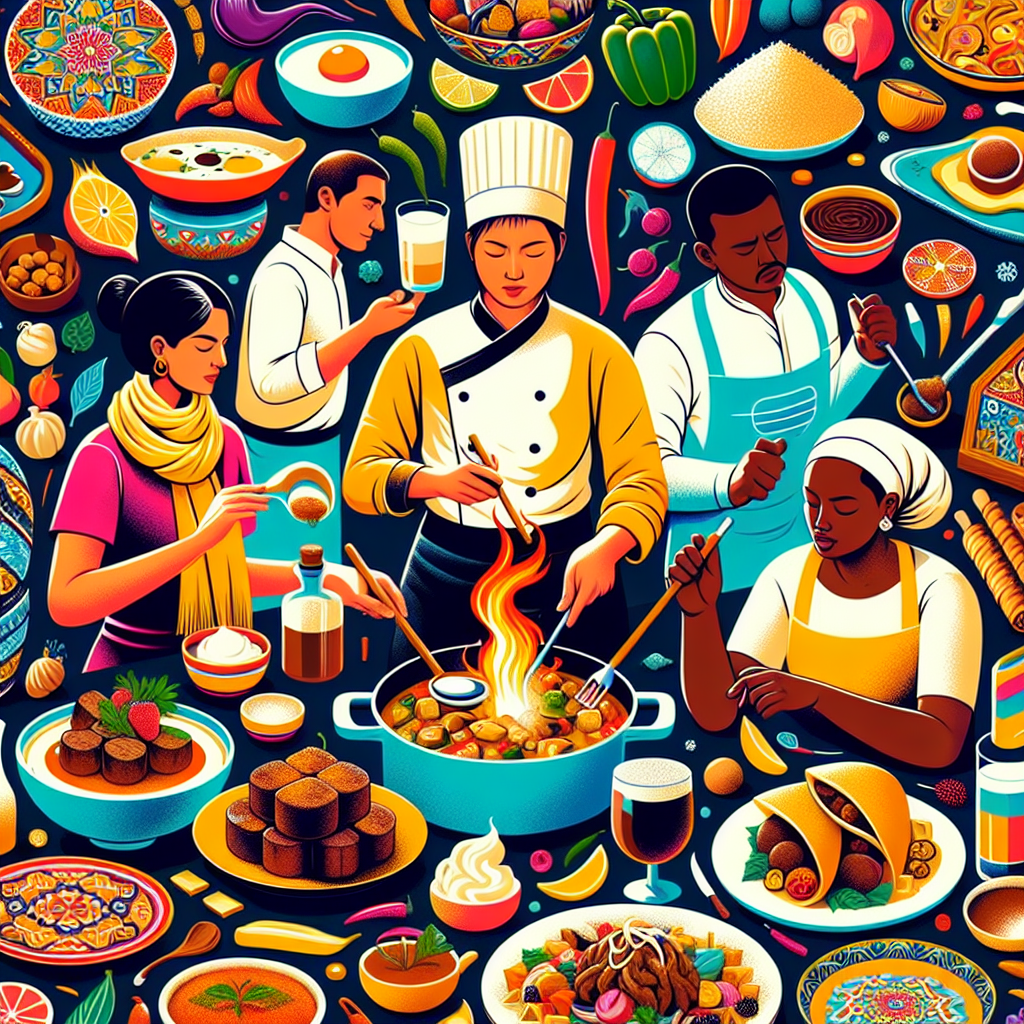
The Art of Spices: A Journey through the Flavors of India, Mexico, and Morocco
When it comes to exploring world cuisines, one cannot ignore the incredible flavors that spices bring to the table. Spices have been an integral part of culinary traditions in various cultures, adding depth, complexity, and a burst of flavor to dishes. In this section, we will take you on a journey through the flavors of India, Mexico, and Morocco, three countries known for their rich and vibrant spice blends.
Let’s start our culinary adventure in India, a country renowned for its diverse and aromatic spices. Indian cuisine is a true celebration of flavors, with each region having its own unique spice blend. One of the most famous spice mixes is garam masala, which typically includes a combination of cinnamon, cardamom, cloves, cumin, coriander, and black pepper. This blend adds warmth and depth to curries, biryanis, and other traditional Indian dishes. Another popular spice blend is curry powder, which varies in composition depending on the region. It usually includes turmeric, cumin, coriander, fenugreek, and chili powder, giving dishes a vibrant yellow color and a spicy kick.
Now, let’s travel to Mexico, a country known for its bold and fiery cuisine. Mexican spices are all about adding heat and intensity to dishes. One of the most iconic spices in Mexican cuisine is chili powder, made from dried and ground chili peppers. It adds a smoky and spicy flavor to salsas, tacos, and enchiladas. Another essential spice is cumin, which brings a warm and earthy taste to Mexican dishes. Cumin is often used in combination with chili powder to create a rich and complex flavor profile. Other common spices in Mexican cuisine include oregano, garlic, and cinnamon, which add depth and complexity to traditional dishes like mole and pozole.
Our final stop on this spice-filled journey takes us to Morocco, a country known for its exotic and aromatic flavors. Moroccan cuisine is a fusion of Mediterranean, Arabic, and Berber influences, resulting in a unique and tantalizing spice palette. One of the most famous spice blends in Moroccan cooking is ras el hanout, which translates to “head of the shop.” This blend can contain up to 30 different spices, including cinnamon, cumin, coriander, ginger, turmeric, and saffron. Ras el hanout adds a warm and fragrant taste to tagines, couscous, and grilled meats. Another essential spice in Moroccan cuisine is cumin, which is used in both savory and sweet dishes, adding a nutty and earthy flavor.
As we conclude our journey through the flavors of India, Mexico, and Morocco, it becomes evident that spices are the heart and soul of these cuisines. They elevate dishes, transport us to different cultures, and awaken our taste buds to new and exciting flavors. Whether it’s the aromatic garam masala of India, the fiery chili powder of Mexico, or the exotic ras el hanout of Morocco, spices have the power to transform a simple meal into a culinary masterpiece. So, the next time you embark on a culinary adventure, don’t forget to explore the world of spices and savor the global flavors they bring to your plate.
From Sushi to Sashimi: Unraveling the Secrets of Japanese Cuisine
Have you ever wondered about the secrets behind the delicious flavors of Japanese cuisine? From sushi to sashimi, Japanese food has gained immense popularity worldwide. In this article, we will take you on a culinary journey through the intricacies of Japanese cuisine, unraveling its secrets along the way.
One of the most iconic dishes in Japanese cuisine is sushi. Sushi is a combination of vinegared rice and various ingredients, such as raw or cooked seafood, vegetables, and sometimes even tropical fruits. The art of making sushi lies in the delicate balance of flavors and textures. The rice should be perfectly seasoned with vinegar, while the fish should be fresh and of the highest quality. The combination of these elements creates a harmonious blend that tantalizes the taste buds.
Another staple of Japanese cuisine is sashimi. Unlike sushi, sashimi consists solely of thinly sliced raw fish or seafood, served with soy sauce and wasabi. The key to sashimi lies in the freshness of the ingredients. The fish should be so fresh that it practically melts in your mouth. The simplicity of sashimi allows the natural flavors of the fish to shine through, making it a true delicacy.
Moving on from raw fish, let’s explore the world of tempura. Tempura is a dish consisting of lightly battered and deep-fried seafood or vegetables. The batter is made from a mixture of flour, water, and sometimes egg. The secret to perfect tempura lies in the batter’s consistency and the temperature of the oil. The batter should be light and crispy, while the oil should be hot enough to quickly cook the ingredients without making them greasy. The result is a dish that is both crispy and light, with a delicate flavor that complements the main ingredient.
Japanese cuisine is also known for its comforting and hearty dishes, such as ramen and udon. Ramen is a noodle soup dish that typically consists of wheat noodles, a flavorful broth, and various toppings such as sliced pork, green onions, and soft-boiled eggs. The broth is the heart and soul of ramen, and it can be made from a variety of ingredients, such as pork bones, chicken, or even seafood. The noodles should be cooked to perfection, with just the right amount of chewiness. The combination of the rich broth, tender meat, and springy noodles creates a bowl of pure comfort.
Udon, on the other hand, is a thick wheat noodle dish that is often served in a soy-based broth. The noodles are typically chewier than ramen noodles, and they are often accompanied by toppings such as tempura or thinly sliced green onions. Udon is a versatile dish that can be enjoyed hot or cold, making it perfect for any season.
Japanese cuisine is a treasure trove of flavors and techniques that have captivated food lovers around the world. From the delicate art of sushi-making to the comforting warmth of a bowl of ramen, Japanese food offers a diverse range of flavors and textures. So the next time you sit down to enjoy a plate of sushi or a steaming bowl of ramen, take a moment to appreciate the secrets behind these culinary delights.
A Taste of the Mediterranean: Exploring the Delights of Greek, Italian, and Spanish Food
When it comes to exploring world cuisines, there is no shortage of flavors to discover. From the spicy dishes of India to the rich and hearty meals of Germany, each country has its own unique culinary traditions. In this guide to global flavors, we will be taking a closer look at the delights of Greek, Italian, and Spanish food – three cuisines that are sure to tantalize your taste buds.
Let’s start our culinary journey in Greece, where the Mediterranean diet reigns supreme. Greek cuisine is known for its use of fresh ingredients, simple flavors, and healthy cooking methods. Olive oil, feta cheese, and yogurt are staples in Greek cooking, and you will find them in many traditional dishes. One such dish is moussaka, a layered casserole made with eggplant, ground meat, and béchamel sauce. Another popular Greek dish is souvlaki, which consists of skewered and grilled meat, usually served with pita bread and tzatziki sauce. Whether you’re a fan of seafood, meat, or vegetarian fare, Greek cuisine has something to offer everyone.
Next, we travel to Italy, the land of pasta, pizza, and gelato. Italian cuisine is beloved around the world for its simplicity and use of high-quality ingredients. From the classic spaghetti carbonara to the comforting lasagna, Italian pasta dishes are a must-try. Pizza, of course, is another Italian staple that has become a global favorite. Whether you prefer a traditional Margherita or a more adventurous topping combination, you can’t go wrong with a slice of authentic Italian pizza. And let’s not forget about gelato – Italy’s answer to ice cream. With its smooth and creamy texture, gelato is the perfect treat to cool down on a hot summer day. So, if you’re a fan of carbs and indulgence, Italian cuisine is sure to satisfy your cravings.
Our final stop on this culinary adventure is Spain, where the flavors are bold and the tapas are plentiful. Spanish cuisine is known for its use of spices, such as paprika and saffron, which add depth and complexity to dishes. One iconic Spanish dish is paella, a rice-based dish typically made with a variety of seafood, meats, and vegetables. Another popular Spanish food is tapas, which are small plates that are meant to be shared. From patatas bravas (fried potatoes with spicy tomato sauce) to gambas al ajillo (garlic shrimp), tapas offer a wide range of flavors and textures. And let’s not forget about sangria – a refreshing and fruity wine-based drink that is perfect for sipping on a warm summer evening. So, if you’re looking for a taste of Spain, be prepared to indulge in bold flavors and a vibrant dining experience.
In conclusion, exploring the delights of Greek, Italian, and Spanish food is a journey worth taking. From the fresh and healthy flavors of Greece to the comforting and indulgent dishes of Italy, and the bold and vibrant cuisine of Spain, each country offers a unique culinary experience. So, whether you’re a fan of Mediterranean flavors, pasta and pizza, or tapas and sangria, there is something for everyone to enjoy. So, grab your passport and embark on a culinary adventure that will leave you craving more.


Pingback: The Art of Plating: Techniques for Beautiful Food Presentation – Just another WordPress site